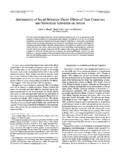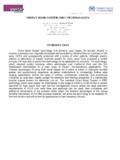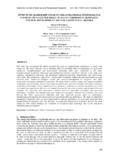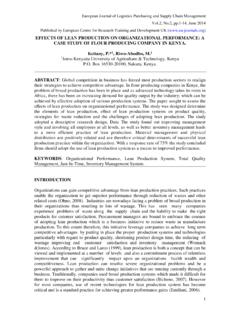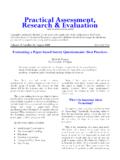Transcription of PHARMACOLOGICAL EFFECTS OF Sapindus mukorossi
1 Rev. Inst. Med. Trop. Sao Paulo54(5):273-280, September-October, 2012doi: Laboratory, Department of Zoology, DDU Gorakhpur University, Gorakhpur, 273009, to: Prof. Singh, Malacology Laboratory, Department of Zoology, DDU Gorakhpur University, Gorakhpur, 273009, UP, India. Tel: +91 551 2202187(O)/0509(R). E-mail: EFFECTS OF Sapindus mukorossiAparna UPADHYAY & SINGHSUMMARYS apindus mukorossi is an extremely valuable medicinal plant, distributed in tropical and sub-tropical regions of Asia. The aim of present review is to form a short compilation of the phytochemical composition and PHARMACOLOGICAL properties of this multipurpose tree. The main phytoconstituents isolated and identified from different parts of this plant are triterpenoidal saponins of oleanane, dammarane and tirucullane type.
2 The structure and chemical names of all the types of triterpenoidal saponins reported in Sapindus mukorossi are included in this review. Many research studies have been conducted to prove the plant s potential as being spermicidal, contraceptive, hepatoprotective, emetic, anti-inflammatory and anti-protozoal. The present review highlights some of the salient PHARMACOLOGICAL uses of Sapindus : Sapindus mukorossi ; Pharmacology; Saponins. INTRODUCTION Sapindus mukorossi Gaertn., a member of the family Sapindaceae, is commonly known by several names such as soapnut, soapberry, washnut, reetha, aritha, dodan and doadni. It is a deciduous tree widely grown in upper reaches of Indo-Gangetic plains, Shivaliks and sub Himalayan tracts at altitudes from 200 m to 1500 m. The Sapindus mukorossi is a fairly large, deciduous tree with a straight trunk up to 12 meters in height, sometimes attaining a height of 20 m and a girth of m, with a globose crown and rather fine leathery foliage.
3 Bark is dark to pale yellow, fairly smooth, with many vertical lines of lenticels and fine fissures exfoliating in irregular wood scales. The blaze is cm, hard, not fibrous, pale orange brown, brittle and granular. Leaves are 30-50 cm long, alternate, paripinnate; common petiole very narrowly bordered, glabrous; leaflets 5-10 pairs, opposite or alternate, 5-18 by cm, lanceolate, acuminate, entire, glabrous, often slightly falcate or oblique; petioles 2-5 m long. Inflorescence is a compound terminal panicle, 30 cm or more in length, with pubescent branches. Flowers are about 5 mm across, small, terminal, polygamous, greenish white, subsessile, numerous, mostly bisexual. Sepals 5, each with a woolly scale on either side above the claw. Fruits are globose, fleshy, 1-seeded drupe, sometimes two drupels together, about cm across.
4 Seeds are cm in diameter, globose, smooth, black and loosely placed in dry fruit is valued for the saponins ( ) present in the pericarp and constitutes up to of the drupe known for inhibiting tumor cell growth37. In China and Japan it has been used as a remedy for centuries. In Japan its pericarp is called enmei-hi , which means life prolonging pericarp and in China wu-huan-zi , the non-illness fruit 37. The major compounds isolated from Sapindus mukorossi are triterpenoidal saponins of mainly three oleanane, dammarane and tirucullane types. Recently many of the PHARMACOLOGICAL actions of this plant have been explored which includes the antimicrobial19, cytotoxic29, molluscicidal16,42, insecticidal12,26, piscicidal44 and fungicidal37,41 activities. One of the most talked about activities of this plant is the contraceptive activity of the saponins extracted from the pericarp of the fruit11, mukorossi is well known for its folk medicinal values30.
5 Pericarps of Sapindus mukorossi have been traditionally used as an expectorant as well as a source of natural surfactant20. Due to the presence of saponins, soapnut is well known for its detergent and insecticidal properties and it is traditionally used for removing lice from the scalp. The fruits are of considerable importance for their medicinal value for treating a number of diseases like excessive salivation, pimples, epilepsy, chlorosis, migranes, eczema and psoriasis21. The powdered seeds are employed in the treatment of dental caries, arthritis, common colds, constipation and nausea8. The seeds of Sapindus mukorossi are used in Ayurvedic medicine to remove tan and freckles from the skin. It cleanses the skin of oily secretion and is even used as a cleanser for washing hair as it forms a rich, natural lather.
6 The leaves are used in baths to relieve joint pain and the roots are used in the treatment of gout and rheumatism. Since ancient times Sapindus mukorossi has been used as a detergent for shawls and silks. The fruit of Sapindus mukorossi was utilized by Indian jewelers for restoring the brightness of tarnished ornaments made of gold, silver and other precious , A. & SINGH, - PHARMACOLOGICAL EFFECTS of Sapindus mukorossi . Rev. Inst. Med. Trop. Sao Paulo, 54(5): 273-80, CONSTITUENTS The major constituents of Sapindus mukorossi fruit are saponins (10% ), sugars (10%) and mucilage10. Saponins are secondary plant metabolites with divergent biological activities10. Sapindus saponins are a mixture of six sapindosides (sapindosides A, B, C, D and mukorozi saponins (E1 and Y1), with sapindoside B as one of the major constituents, isolated by n-butanol extraction of the ethanolic extract of fruit pericarp of Sapindus mukorossi and identified by liquid chromatography and mass spectroscopy28.)
7 Saponins are a large family of structurally-related compounds of steroid or triterpenoid aglycone (sapogenin) linked to one or more oligosaccharide moieties by glycosidic linkage. The aglycone, or sapogenin, may contain one or more unsaturated C-C bonds. The oligosaccharide chain is normally attached at the C3 position (monodesmosidic), but many saponins have an additional sugar moiety at the C2,6 or C2,8 position (bidesmosidic)10. The great complexity of the saponin structure arises from the variability of the aglycone structure, the nature of the side chains and the position of attachment of these moieties on the aglycone10. The carbohydrate moiety consists of pentoses, hexoses or uronic acids. Due to this complexity, saponins are difficult to classify. Because it is no longer customary to classify compounds based on their physicochemical or biological properties, a state of the art classification based on the biosynthesis of the saponin carbon skeletons was proposed by VINCKEN et Different types of triterpene, saponins of oleanane, dammarane and tirucullane type were isolated from the galls, fruits and roots of Sapindus mukorossi .
8 Oleanane type triterpenoid saponins named Sapindoside A&B (Fig. 34 & 35) were reported from the fruits of Sapindus mukorossi6. Sapindoside C (Fig. 36)4, Sapindoside D (Fig. 37)5, which is a hexaoside of hederagenin, and Sapindoside E (Fig. 38)3, a nonaoside of hederagenin, was isolated and identified from the methanolic extract of the fruits of Sapindus mukorossi . Dammarane-type saponins, named Sapinmusaponins A & B (Fig. 11 & 12), C-E (Fig. 15, 16, 17), together with three known phenylpropanoid glycosides, were isolated from the galls of Sapindus mukorossi45. Tirucallane-type saponins, sapinmusaponins F-J (Fig. 18-22), were isolated from the galls of Sapindus mukorossi as reported by HUANG et The structures of these saponins were elucidated on the basis of spectroscopic analysis including 1D and 2D NMR techniques.
9 Triterpene saponins of oleanane type like, Sapinmusaponin K-N (Fig. 25-28), Mukorozisaponin G & E1 (Fig. 29-30), Sapindoside A & B along with dammarane types like Sapinmusaponin O and P (Fig. 13 & 14) were isolated from fruits and the galls of Sapindus mukorossi as per HUANG et In another study by NAKAYAMA et , Mukorozisaponin Y1 (Fig. 31), Y2 (Fig. 32), X (Fig. 33) were isolated from the pericarp of Sapindus of an ethanolic extract of the galls of Sapindus mukorossi has resulted in the isolation of two tirucallane type triterpenoid saponins, sapinmusaponin Q and R (Fig. 23-24), along with three known oleanane type triterpenoid saponins: sapindoside A, sapindoside B, and hederagenin-3-O-[ -D-xylopyranosyl-(1 3)]- -L-rhamnopyranosyl-(1 2)+- -L arabinopyranoside14. The roots of Sapindus mukorossi contain tirucallane-type triterpenoid saponins like Sapimukoside A & B38, Sapimukoside C &D25.
10 Further investigation of the roots of Sapindus mukorossi by NI et reported the presence of Sapimukosides E-J24. The structures of Sapimukosides A-J are shown in Fig. 1 to Fig. 10 respectively. Table 1 shows whole view of all the saponins isolated from Sapindus EFFECTS1. Anti-bacterial activity: IBRAHIM et evaluated that ethanolic and chloroform extracts of Sapindus mukorossi inhibited the growth of Helicobacter pylori (both sensitive and resistant), at very low concentrations, when given orally for seven days to male wister rats. In the in vitro study, the isolates show a considerable zone of inhibition at very low concentration (10 g/mL) and in the in vivo Fig R1 R2 1 3-AraGlc 2-RhaH 2 Glc6-Rha H 3 3-AraGlc 2-RhaEt 4 3-AraGlc 2-Rha Me 5 3-AraGlc 2-Rha3-Ara Et 6 3-AraGlc 2-Rha3-XylEt 7 3-AraGlc 2-Rha3-XylMe 8 3-AraGlc 2-Rha3-AraEt9 3-RhaGlc2-Rha3-AraMe10 Glc6-Rha EtAbbreviationsGlc: -D-GlucopyranosylRha: -L-hamnopyranosyl Ara: -L-rabinopyranosyl Xyl: -D-Xylopyranosyl UPADHYAY, A.











